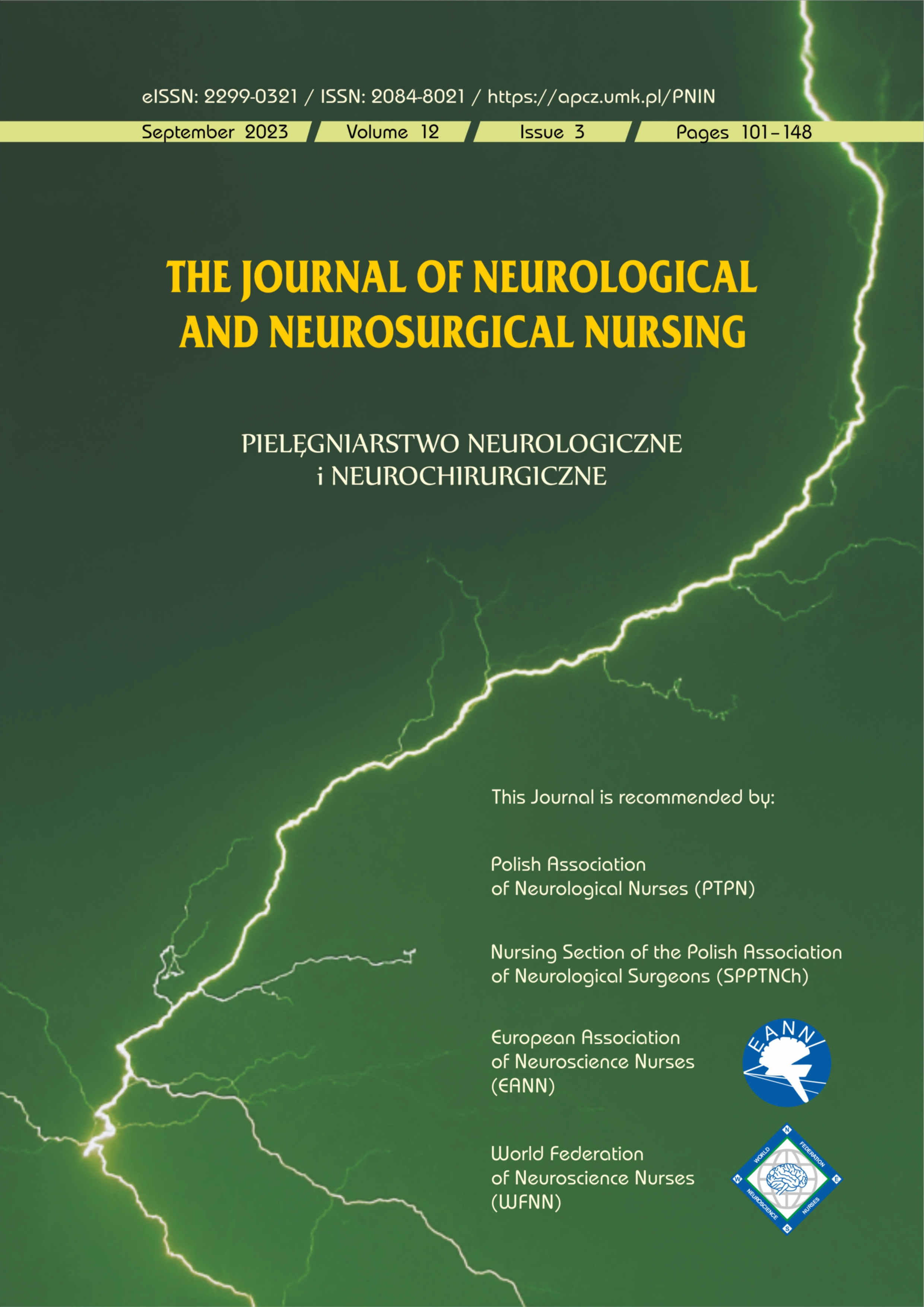Śródoperacyjny monitoring neurofizjologiczny w operacjach tarczycy jako metoda ograniczania deficytów neurologicznych
DOI:
https://doi.org/10.15225/PNN.2023.12.3.2Słowa kluczowe
śródoperacyjny neuromonitoring, deficyty neurologiczne, neuromonitoring, neurofizjologia, tarczyca, choroby tarczycyAbstrakt
Wstęp. Neuromonitoring śródoperacyjny polega na stymulacji prądem nerwu krtaniowego zlokalizowanego w pobliżu tarczycy. Natężenie jest zwykle ustawiane w granicach 1–2 mA, aby mogło dać pożądany efekt, ale dać również selektywność kontrolowanych nerwów. Ładunek ma na celu stymulację strun głosowych i unerwienia ruchowego w obrębie krtani, szczególnie w rejonie tkanek poddanych operacji.
Cel. Celem pracy było przedstawienie śródoperacyjnego monitorowania nerwu krtaniowego wstecznego jako metody zmniejszania częstości występowania działań niepożądanych związanych z uszkodzeniem nerwu krtaniowego oraz porównanie jakości życia pacjentów, którzy podczas zabiegów byli neuromonitorowani do tych którzy mieli przeprowadzoną operację bez wykorzystania neuromonitoringu śródoperacyjnego.
Materiał i metody. Badanie zostało przeprowadzone w dwóch grupach badawczych. Pierwszą z grup stanowiło 100 pacjentów firmy CentroMedica Sp. z o.o. z terenu całej Polski, którzy zostali poddani operacji wycięcia guza tarczycy przy asyście neuromonitoringu. Drugą grupę badawczą stanowiło 100 pacjentów tej samej firmy. Również zostali oni poddani zabiegowi wycięcia guzów w obrębie tarczycy, jednak w ich przypadku bez wykorzystania neuromonitoringu. W badaniu opisanym w niniejszej pracy zastosowano metodę sondażu diagnostycznego wykorzystując kwestionariusz stanu zdrowia HAQ i analizę opracowań dokumentacji medycznej.
Wyniki. U pacjentów po zabiegach bez użycia monitoringu śródoperacyjnego częściej zaobserwowano powikłania po operacji niż u pacjentów z monitoringiem. Pacjenci po zabiegach bez neuromonitoringu częściej miewali chrypkę jako powikłanie po zabiegu.
Wnioski. Na podstawie przeprowadzonych badań można stwierdzić, że śródoperacyjny neuromonitoring podczas operacji tarczycy ma wpływ na lepszą jakość życia pacjentów po zabiegu. (PNN 2023;12(3):112–119)
Bibliografia
Huber J., Wincek A., Kubaszewski Ł., Dąbrowski M., Kaczmarek K., Kotwicki T. Monitoring neurofizjologiczny wykonywany w trakcie operacji chirurgicznych związanych z podwyższonym ryzykiem uszkodzenia struktur nerwowych. Praktyczna Ortopedia i Traumatologia. 2019;13.
Flisberg K., Lindholm T. Electrical stimulation of the human recurrent laryngeal nerve during thyroid operation. Acta Otolaryngol Suppl. 1969;263:63–67.
Karnofsky D.A., Burchenal J.H. The Clinical Evaluation of Chemotherapeutic Agents in Cancer. In MacLeod C.M. (Ed.), Evaluation of Chemotherapeutic Agents. Columbia University Press, New York 1949;196.
Babbie E. Badania społeczne w praktyce. Wydawnictwo Naukowe PWN, Warszawa 2007.
Higgins T.S., Gupta R., Ketcham A.S., Sataloff R.T., Wadsworth J.T., Sinacori J.T. Recurrent laryngeal nerve monitoring versus identification alone on post-thyroidectomy true vocal fold palsy: a meta-analysis. Laryngoscope. 2011;121(5):1009–1017.
Sanabria A., Ramirez A., Kowalski L.P. et al. Neuromonitoring in thyroidectomy: a meta-analysis of effectiveness from randomized controlled trials. Eur Arch Otorhinolaryngol. 2013;270(8):2175–2189.
Barczyński M., Konturek A., Cichoń S. Randomized clinical trial of visualization versus neuromonitoring of recurrent laryngeal nerves during thyroidectomy. Br J Surg. 2009;96(3):240–246.
Alesina P.F., Rolfs T., Hommeltenberg S. et al. Intraoperative neuromonitoring does not reduce the incidence of recurrent laryngeal nerve palsy in thyroid reoperations: results of a retrospective comparative analysis. World J Surg. 2012;36(6):1348–1353.
Sopiński J., Kuzdak K., Hedayati M., Kołomecki K. Role of intraoperative neuromonitoring of the recurrent laryngeal nerves during thyroid reoperations of recurrent goiter. Pol Przegl Chir. 2017;89(3):11–15.
Pobrania
Opublikowane
Jak cytować
Numer
Dział
Licencja

Utwór dostępny jest na licencji Creative Commons Uznanie autorstwa – Bez utworów zależnych 4.0 Międzynarodowe.
Statystyki
Liczba wyświetleń i pobrań: 378
Liczba cytowań: 0
